U. E. Duschanov1, H. U. Bekchanov2
1Urganch State University, Urganch City
2Urganch Pedagogical Institute, Prof. Doctor of Biological Sciences
Correspondence to: U. E. Duschanov, Urganch State University, Urganch City.
| Email: |  |
Copyright © 2023 The Author(s). Published by Scientific & Academic Publishing.
This work is licensed under the Creative Commons Attribution International License (CC BY).
http://creativecommons.org/licenses/by/4.0/

Abstract
In this article, for the first time, information is presented on the species composition of ground beetles (coleoptera, carabidae) in the agrobiocenosis zones of the Khanka, Bogot, Urgench, Yangibozor and Gurlan regions of the Khorezm region. In these areas, 13 subfamilies, 18 tribes, 31 genera, and 59 species belonging to 31 subgenera have been identified. The highest indicator of the beetle fauna of the region, i.e. the top 10% is represented by representatives of the subfamily Trechinae with 7 species and 12%, Scaritinae with 8 species (14%), Cicindelinae with 9 species (15%), and the most identified species from the representatives of the subfamily Harpalinae prevailed with 15 species with a share of 26%.
Keywords:
Khorezm, Agrobiocenosis, Beetles, Ground beetles, Trehines, Scaritins, Cycindelins, Harpalins, Taxonomic, Salt marshes, Abiotic, Hydroedaphic, Biotic
Cite this paper: U. E. Duschanov, H. U. Bekchanov, Taxonomic Analysis of Coleoptera, Carabidae Distributed in Agrobiocenoses of Khorazm Region, International Journal of Genetic Engineering, Vol. 11 No. 2, 2023, pp. 22-29. doi: 10.5923/j.ijge.20231102.03.
1. Introduction
Carabidae family of Coleoptera is one of the largest families with 25,000 to 50,000 species. These beetles are very sensitive to moisture from abiotic factors. Most of the species are adapted to live in humid biotopes with relatively moderate temperatures. The share of mesoxerophilic species among phytophages is quite high, because these species, like other phytophages, compensate for the lack of moisture in the body at the expense of plant tissues. A large group of ground-dwelling beetles is specialized for living in highly saline and brackish soils. Based on this, we set ourselves the goal of studying the fauna of the agrocenosis vizildok beetles in the vicinity of the forest and lake on the shores of the Amudarya in the Khorezm region. (2-3-4 Figures)It is no secret that they occupy the main positions in the protection of agricultural crops from pests due to their predatory nature, which is a constant control of the number of species that are abundant in all natural and anthropogenic environments and damage agricultural crops, including beetles of the genera calosama, carabus, bembidion and scarits in biological control. is of particular importance.In addition, some types of weevils damage agricultural crops. For this reason, the study of carabid beetles (Carabidae) from a general biological and faunistic point of view is considered relevant.In 1868-1871 A.P. Fedchenko entomofauna of the region of the Nurota Mountains and the southern parts of the Kyzylkum Desert [17], in 1957-1959 the entomofauna of the Nurota Mountains and the desert areas adjacent to it were studied by V.V. Yakhontov, [15] A.G. Davleshina, V.M. Vasenkova, studied by P.N. Korshin. [6]In Uzbekistan, studies on the study of hardy species belonging to the subgenus Adephaga are mainly in South-Western and South-Eastern Kyzylkum (Davleshina et al., 1974, 1975, 1982, 1984) [6] Fergana Valley, Tashkent (D. Dadamirzaev 1972-1976), [5] In the agrocenoses of Jizzakh, Bukhara, Kashkadarya regions (D. Daminova, 2010), it was conducted by, in which the systematics, ecologic-faunistic characteristics of these beetles, and their role in agrocenoses were shown. Nevertheless, for the first time, special studies are being conducted to study the carabid fauna of the agrobiocenosis areas of the Khorezm region.
2. Material and Methods
During 2021-2023, our research was conducted in the following coordinates of agrobiocenoses of Khanka, Bogot, Urganch, Yangibozor and Gurlan districts of Khorezm region. (Figure 1) | Figure 1. Locations where research was conducted |
Bogot region-41°20'03.0"N 60°54'22.0"E, 41°24'31.9"N 61°00'39.5"E, 41°21'40.5"N 60°47'20.9"E, 41°25'19.6"N 61°00'56.3"E,41°24'33.4"N 61°00'38.8"E. Khanka region- 41°24'11.0"N 60°41'50.0"E, 41°25'27.5"N 60°43'02.0"E, 41°25'23.0"N 60°41'10.0"E, 41°30'07.8"N 60°52'05.1"E, 41°25'40.0"N 60°43'47.0"E, 41°31'09.0"N 61°00'36.0"E, 41°26'14.0"N 60°40'02.0"E, 41°24'11.0"N 60°41'50.0"E, 41°27'42.5"N 60°57'13.8"E. Urganch region- 41°37'32.0"N 60°41'10.0"E, 41°35'48.9"N 60°44'44.9"E, 41°35'56.3"N 60°44'43.6"E, 41°35'49.0"N 60°44'43.5"E. Yangibozor region-41°43'01.9"N 60°36'21.6"E, 41°42'50.3"N 60°36'59.5"E. Gurlan region-41°57'35.1"N 60°17'04.1"E, 41°53'51.8"N 60°24'23.3"E, 41°53'51.3"N 60°24'07.9"E, 41°54'10.4"N 60°24'09.3"E. | Figure 2. Biotope (A) |
 | Figure 3. Biotope (A) |
 | Figure 4. Biotope (O') |
Khorezm region occupies part of the ancient Khorezm lands in the north-western part of the Republic of Uzbekistan, on the left bank of the lower Amudarya. The geographical location of the region is between 60°03'-62°28' east longitude and 40°35'-42°00'' north latitude. The region is bordered by Turkmenistan through the Karakum to the south and southwest, by the Republic of Karakalpakstan through the Amudarya to the northwest and north, and by the Bukhara regions to the southeast.The region stretches for 280 km from northwest to southeast, and 80 km from west to east in the width where the city of Urganch is located. The northernmost point of the region corresponds to the Nuronbabo grove near the village of Olchin, Gurlan district. The southern end point is located a little south of Tuproqkala.The Karakum and Kyzylkum deserts are the main factors influencing the formation of Khorezm's nature and relief. In addition, the Amudarya and the sediments brought by it play an important role in the uniqueness of its nature and relief. The passage of the Amudarya through the Khorezm region creates the ground for underground water to be close to the surface of the earth [1].Collecting samples of weevildak beetles was widely used general entomological methods and special methods developed for the genus Hardy (Barber, 1931; Geidman, 1955, 1956) [3].Many beetles are characterized by a desire for light at night. Some of them fly to ultraviolet rays (Fig. 7). It will be possible to observe flying insects at night by placing a flashlight on a white cloth. A family of beetles living outdoors on plants was caught with a trap. Many beetles live on the ground and in trees, bushes, and gardens. Beetles of this type can be caught mainly by hand (Fig. 5-6), by sifting the soil (Fig. 9) or by the above methods. Odor emitting devices attract many insects well to the odors of organic substances, especially the substances emitted by the insects themselves.0.5 l glass jars were used as jar holders. The handles were buried in the soil up to the edges, and ¼ volume of fixative liquid was poured into them (Fig. 8-10). | Figure 5 |
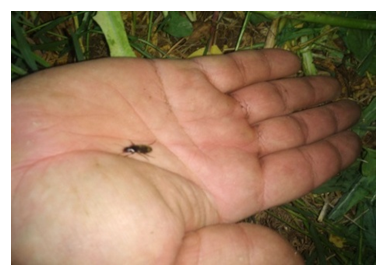 | Figure 6 |
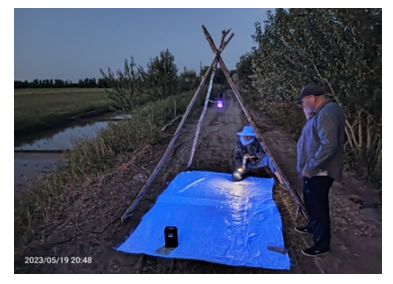 | Figure 7 |
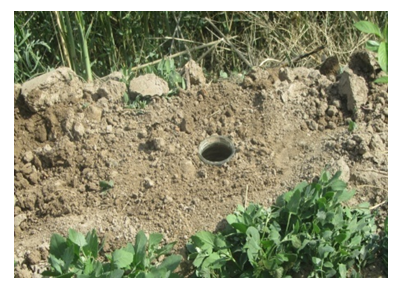 | Figure 8 |
 | Figure 9 |
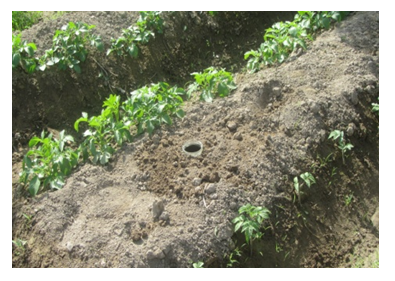 | Figure 10 |
As a result of our three-year research, the beetle identifier for processing, identification and species identification of collected materials (G.G. Yakobson V. Martyanov 2017) [16] Catalog of Palaearctic Coleoptera VOLUME 1, [13] and Russia and the pamphlets of the list of ground beetles of the neighboring areas were used (O.L. Kryzhanovski, I.A. Belousov, I.I. Kabak, B.M. Kataev, K.V. Makarov, V.G. Shilenkov 1995) [11] collected collections were transferred to the fund of the entomology unique collection of the Institute of Zoology of the Academy of Sciences of the Republic of Uzbekistan.Along with the wide use of modern atlases and catalogs in determining the species composition of the collected hardy plants, a number of mature specialists of the world, the employee of the All-Russian Plant Protection Institute of the Russian Academy of Sciences b.f.n. I. I. Kabak, Siberian Branch of the Russian Academy of Sciences "Head of the Department of the collection of ground beetles (Coleoptera, Carabidae) of the Siberian Museum of Zoology, Ph.D. M. V. Nabojenko helped closely. Here we express our gratitude to them.
3. Results and Discussion
During the research, more than 720 samples of vizildok beetles were collected and analyzed. 13 subfamilies, 18 tribes, 31 genera, and 59 species belonging to 31 subgenera were identified in the riverside agrobiocenoses of Khorezm region. (Table 1)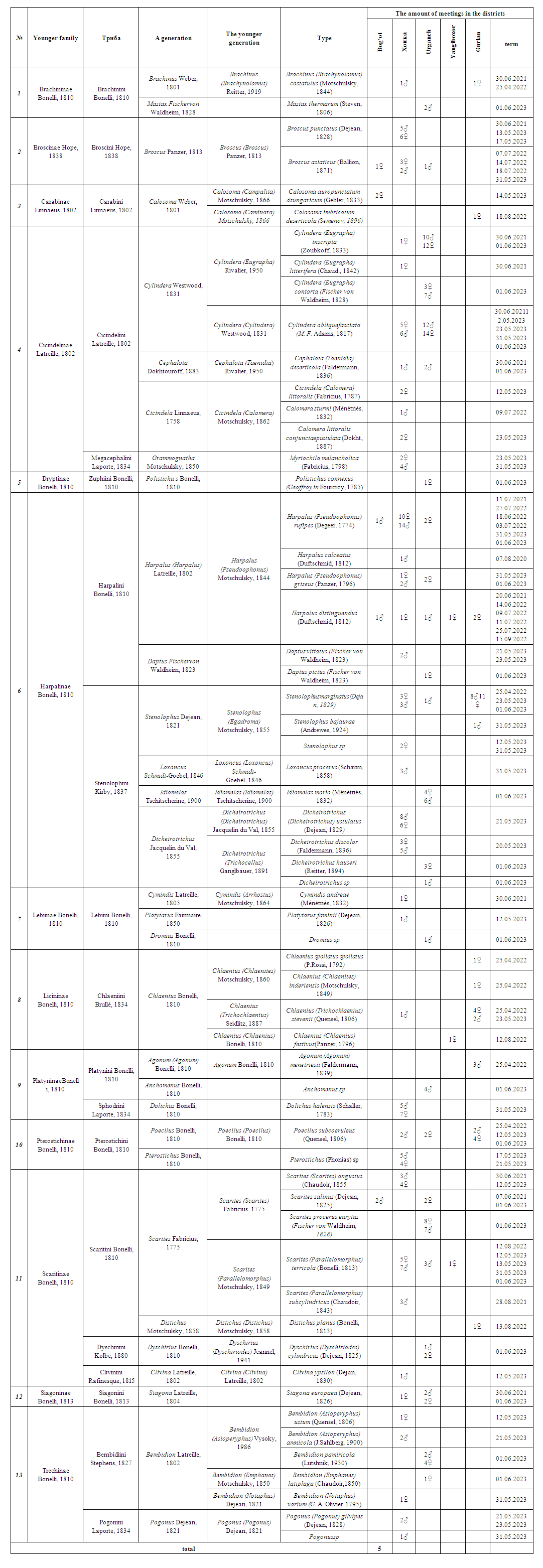 | Table 1. Meeting of species of the Carabidae family in the region |
4. Conclusions
The analysis of the number of species in the agrobiocenosis areas of the identified weevil beetles shows that the highest number belongs to the Harpalinae subfamily and made up 15 species (26%), and the lowest number belongs to the Sigonninae subfamily. Formed 1 type (2%) (Figure - 11).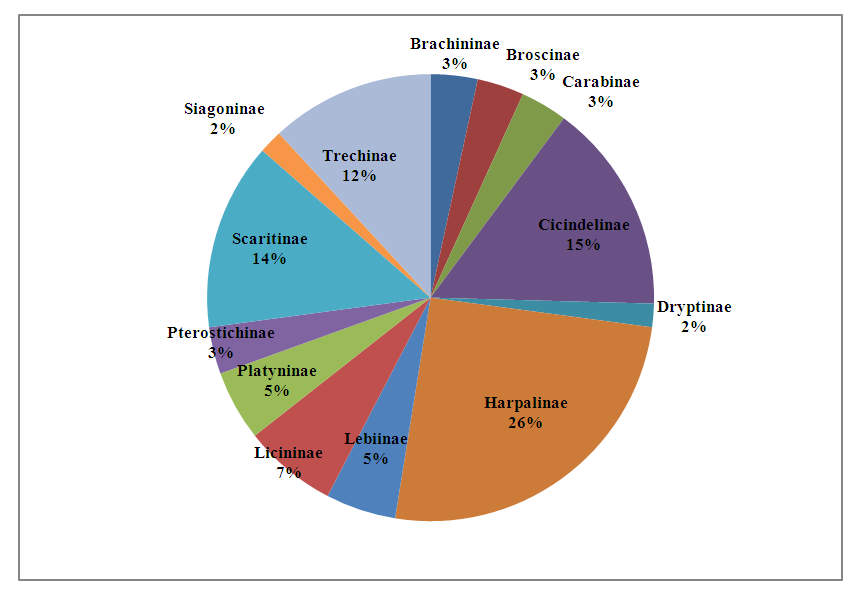 | Figure 11. Proportion of species of Carabidae family by subfamilies |
References
| [1] | Allabergenov, T. Kh. Physical-geographical zoning of the Khorezm oasis and adjacent territories: Abstract of the thesis. for the academic degree cand. geogr. Sciences / Kazan. state un-t im. V. I. Ulyanov-Lenin. Kazan: [b. and.], 1966. - 20 p. (Russian) |
| [2] | Aleksandrovich O.R. 1993. Ecological and faunistic review of ground beetles (Coleoptera, Carabidae) in the west of the forest zone of the Russian Plain: Manuscript dep. in NPO "Veras" 21.10.92, N 150. - Minsk: NPO "Veras". 1993, 82 p. (Russian) |
| [3] | Soboleva-Dokuchaeva, I.I. Some factors determining the effectiveness of Barber traps I.I. Soboleva-Dokuchaeva, T.A. Soldatova Nauch. report higher school Biol. Sciences. 1980. No. 11. S. 96–101. (Russian) |
| [4] | Agroecological atlas. Russia and neighboring countries: economically significant plants, their pests, diseases and weeds. 2008, (Russian) |
| [5] | Guseva O.G., Koval A.G. Peculiarities of complexes of ground beetles (Coleoptera, Carabidae) in agrocenoses of the Leningrad region with different soil conditions / Bulletin of Plant Protection. No. 4. pp. 3–11. (Russian) |
| [6] | Guseva O.G., Koval A.G. Ground beetles (Coleoptera, Carabidae) in agrocenoses of field crops and surrounding biotopes / Science, production, business. Materials of the international scientific and practical conference, Almaty, April 4–5, 2019. Volume 1. Almaty. P.241. (Russian) |
| [7] | Guseva O.G. 2018. Distribution of ground beetles of the genus Poecilus Bonelli, 1810 (Coleoptera, Carabidae) in agricultural landscapes of the North-West of Russia / Acta Biologica Sibirica. Volume 4. No. 3. P.102–107. (Russian) |
| [8] | Dadamirzaev A., Davleshina A.G., Ground beetles in gardens of Uzbekistan. Protection of plants. 1982. No. 9. S. 32. (Uzbek) |
| [9] | Davletshina. A.G., Dadamirzaev A.A., "On the species composition and distribution of ground beetles (family Carabidae) in various objects of the Tashkent region." Problems of Soil Zoology, vol. Vilnius, 1975, pp. 136-137. (Uzbek) |
| [10] | Dedyukhin S.V. Principles and methods of ecological and faunistic studies of terrestrial insects (educational manual). (Russian) |
| [11] | Izhevskii S.S., Lobanov A.L., Sosnin A.Yu. Life of wonderful beetles. Publishing house "Kodeks". Moscow. 2014. pp. 73-75. (Russian) |
| [12] | Kasandrova L. I., Sharova I. Kh. Development of field beetles Amara ingenua, Anisodactylus signatus and Harpalus distinguendus (Coleoptera, Carabidae) Zoological Journal. 1971. V. 50, no. 2. S. 215-221. (Russian) |
| [13] | Kryzhanovsky O.L. Ground beetles of Central Asia of the genus Carabus. 1953 (Russian) |
| [14] | Kryzhanovskii O.L., Belousov I.A., Kabak I.I., Kataev B.M., Makarov K.V., Shilenkov V.G. A checklist of the ground-beetles of Russia and adjacent lands (Insecta, Coleoptera, Carabidae). Pensoft Series Faunistica, N 3. Sofia-Moscow: Pensoft Publishers. 1995. 271 p. |
| [15] | Kryzhanovsky O.L. Family Ground beetles-Carabidae. Key to harmful and beneficial insects and mites of grain crops in the USSR. (Kopaneva L.M. ed.). L.: Kolos. 1980. S. 103-109. (Russian) |
| [16] | Catalogue of Palaearctic Coleoptera VOLUME 1 2017 (Archostemata-Myxophaga-Adephaga Revised and Updated Edition Volume 1 Edited by I. Löbl D. Löbl). ISBN 978-90-04-33028-3 (hardback). |
| [17] | Lopatin I.K. Leaf beetles of Central Asia and Kazakhstan. Publishing house "Science" of the Leningrad branch. Leningrad. 1977 pp. 243-245. |
| [18] | Yakhontov V.V. Entomological collection. To the 60th anniversary of the birth of V.V. Yakhontov. Tashkent, 1960. |
| [19] | Yakobson G. G. Determinant of beetles. Edition 2 supplemented by Ogloblin D.A. State publishing house of agricultural and collective farm-cooperative literature. Moscow-1931-Leningrad. |
| [20] | Yunusov M.M., Khabibullaev F.N., Yulbarsova I.I. Collecting hardy birds and making collections from them. "SCIENTIFIC PROGRESS" Scientific Journal ISSN: 2181-1601 Volume: 1, ISSUE: 4. |
| [21] | Fedchenko A.P. Brocknaus and Efron's encyclopedic dictionary in 86 volumes. St. Petersburg. 1890-1907. (Uzbek) |















 Abstract
Abstract Reference
Reference Full-Text PDF
Full-Text PDF Full-text HTML
Full-text HTML